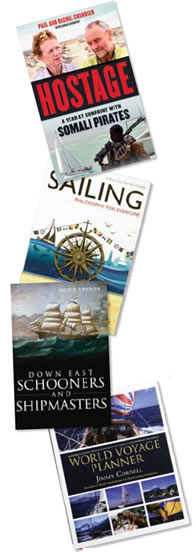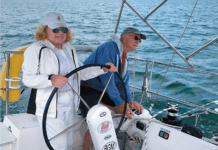

Ready to tuck yourself under a warm blanket with a good book this winter? Here are a few recommended reads from the editors at Practical Sailor.
On Oct. 23, 2009, Somali pirates kidnapped Paul and Rachel Chandler from their sailboat, the Lynn Rival, in the Seychelles, in the Indian Ocean. Hostage (Chicago Review Press, 2012, by Paul and Rachel Chandler with Sarah Edworthy, $12, $10 Kindle) recounts their terrifying ordeal. After ransacking the Chandlers boat and forcing them onto a ship with other captives, the pirates took the couple hundreds of miles to Somalia, where they were held for more than a year. The book, a true, day-to-day account, tells how the Chandlers were threatened, intimidated, whipped, and even placed in solitary confinement while the pirates demanded ransoms that their families could not afford. The Chandlers raw and remarkable memoir recounts their ordeal and ultimate passage to freedom.
Sailing, Philosophy For Everyone: Catching the Drift of Why We Sail (Wiley-Blackwell, 2012, Edited by Patrick Goold, $12, $10 Kindle) is a compelling collection of essays that addresses the question, Why do we sail? The essays are divided into such sections as Passing through Pain and Fear, Three Schools of Thought, Beauty and Other Aesthetic Aspects of the Sailing Experience, and Physics and Metaphysics for the Philosophical Sailor. The essay authors include philosophers and academics, as well as sailors themselves. The writings address the meaning and value of sailing. Deep thoughts for a long winters day.
To take to the sea and sail has always been at the heart of Down East Maine. In Down East Schooners and Shipmasters (The History Press, 2012, $15, $10 Kindle), author Ingrid Grenon presents compelling stories from the decks of Down East Maines schooners, from the early days of the search for a Northwest Passage to the quest for the mysterious and illusive settlement of Norumbega. The histories of Mount Desert Island, Hancock, Bar Harbor, and other Maine towns and harbors are intertwined with the history of these iconic, majestic vessels.
Iconic world cruiser Jimmy Cornell is at it again, with his latest, and greatest, day-planner on world travel. World Voyage Planner (Paradise Cay Publications, 2012, $45, www.cornellsailing.com), is designed to help sailors plan a voyage anywhere in the world, with suggestions of alternative routes to certain destinations, recommended departure dates and favorable sailing seasons, tropical storm areas and the critical sailing months, suggested detours to attractive places, and strategically located ports of call in case of emergency. This incredibly well-organized planner is efficiently and attractively presented. Fourteen books later, World Voyage Planner is one more Cornell publication we recommend making room for on your shelf.
Robb White, who passed away in 2006, was a master of the art of spinning a good yarn. He was an old salt, dispensing copious wisdom and entertainment in a voice that is part Florida cracker, and part biology professor. Whites Flotsam and Jetsam: The Collected Adventures, Opinions and Wisdom from a Life Spent Messing About in Boats (Breakaway Books, 2009, $14) revolves around boats and boatbuilding, with countless sidetracks into such esoterica as clam chowder, sawmills, cast-netting, and alligators. His style mines a deep vein of Southern eccentricity and charm, while imparting a great deal of practical and technical wisdom. Flotsam and Jetsam is a must-read for anyone who loves boats, and who values the old ways of doing it yourself.
If your winter adventures include abandoning ship with the ultimate ditch bag, then Frances and Michael Howorths The Grab Bag Book: Your Ultimate Guide to Liferaft Survival, (Paradise Cay Publications, 2002, $10) is the book for you. And if your plans don’t include an emergency evacuation followed by 40 days in a life raft, now is always the best time to prepare. The Grab Bag Book categorizes preparation and survival into coastal versus offshore, hot versus cold climates, and short cruises versus circumnavigations. The book includes ditch-bag packing guidelines and concise sea survival advice. It addresses safely abandoning ship, immediate and long-term survival in a life raft, and the management of dehydration, hypothermia, sunburn, vomiting, salt-water boils, and general first aid.
When Gib Peters was diagnosed with Lou Gehrigs disease (also known as ALS), he decided to embark on a physical and spiritual journey, fighting the fatal disease on his own terms. Written by Peters neurologist, Walter G. Bradley, Gibs Odyssey: A Tale of Faith and Hope on the Intracoastal Waterway (Lyons Press, 2011, $12, $10 Kindle) is the story of Peters solo sail from Key West, Fla., to New York and back while suffering from advanced stages of the disease. Peters fed himself through a tube inserted in his stomach, used a mechanical voice on the VHF radio because he was unable to speak, and near the end as he was forced to cope with increasing levels of paralysis, he steered his boat with his feet. This inspirational book is a story of a man who left a lasting mark on his community by conquering despair and choosing a life of adventure with the precious time he had left.
Team Spirit: Life and Leadership On One of the Worlds Toughest Yacht Races by Brendan Hall (Adlard Coles Nautical, 2012, $16) is the gripping account of the 2009-2010 Clipper Round the World Yacht Race and a young skippers determination and victory. The youngest and least-experienced skipper in the race, 28-year-old Brendan Hall, won the 2010 race, along with his crew on board Spirit of Australia. Halls story shows that his phenomenal win was no accident, but was the culmination of expert training, skilled navigation, and an innate leadership quality well beyond the young skippers years.
All Standing: The Remarkable Story of the Jeanie Johnston, the Legendary Irish Famine Ship by Kathyrn Miles (Free Press, 2013, $17, $13) recounts the 11 journeys of this famous ship, its heroic crew, and the immigrants who were ferried between Ireland and North America. More than a million people attempted to flee the Irish famine, and more than 100,000 of them died aboard the 5,000 aptly named coffin ships. But in the face of horrific losses, a small ship named the Jeanie Johnston never lost a passenger. Using newspaper accounts, rare archival documents, and her own experience sailing as an apprentice aboard the recently re-created Jeanie Johnston, Miles tells the story of these extraordinary people and the revolutionary milieu in which they set sail. What the crew-and their ship-accomplished over the course of 11 voyages to North America was the stuff of legend.
When Michael Hurleys world foundered in the wake of infidelity, divorce, and failure, he took to the sea and sought perspective from the decks of a 32-foot sailboat, Gypsy Moon. He was short of money, out of a job, and seeking to salvage a life that had swamped. Once Upon a Gypsy Moon (Hatchett Book Group, coming April 2013, $12, $10 Kindle) is the story of his two-year outward journey and inward odyssey. Beset by rough weather and his boats mechanical troubles, Hurleys story of sailing south from Annapolis, Md., to the Caribbean will resonate with anyone who has had to pick up the pieces in the wake of personal failure and loss.





































